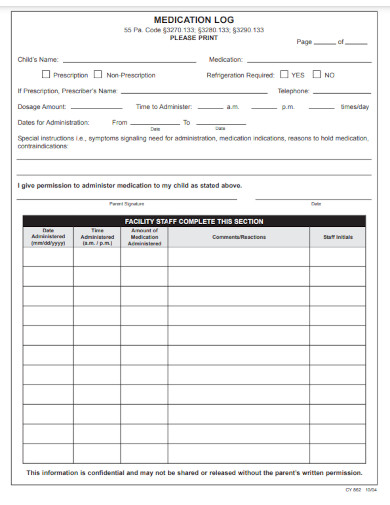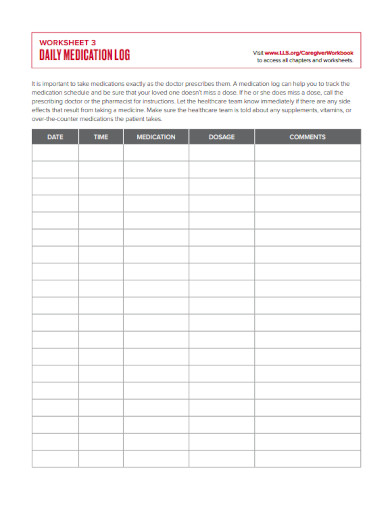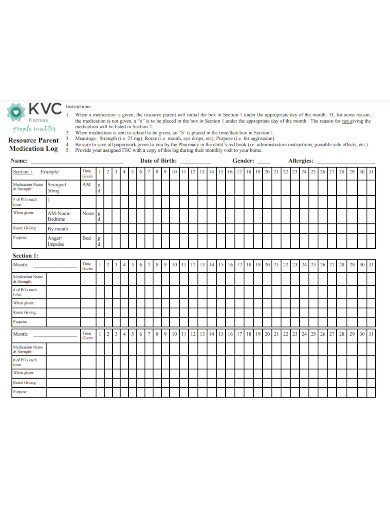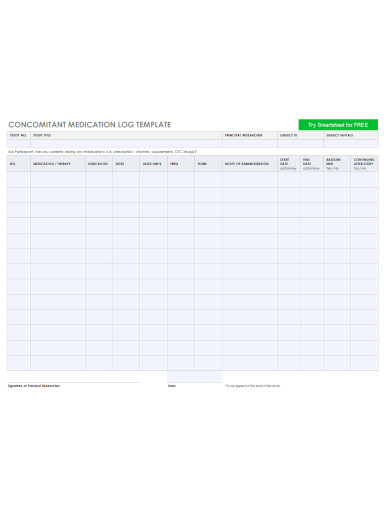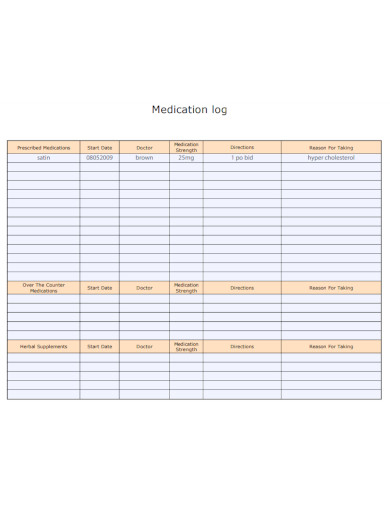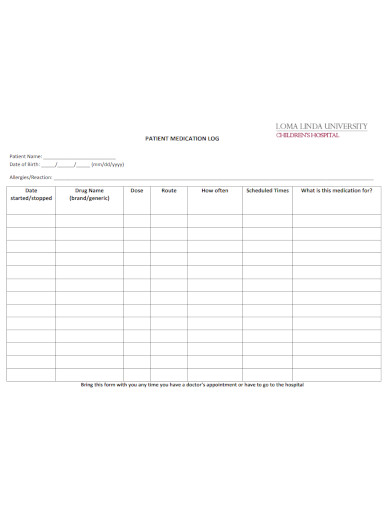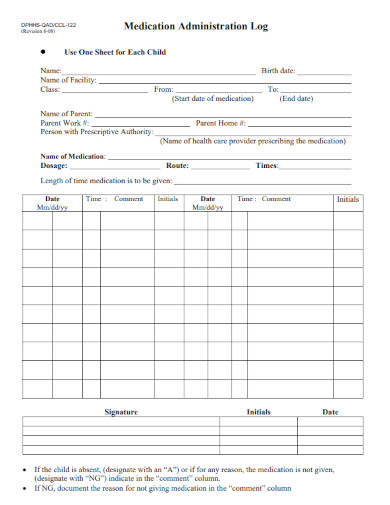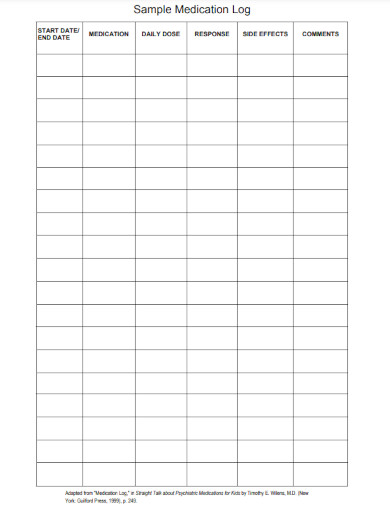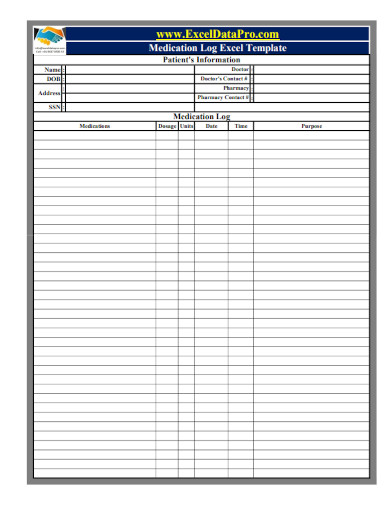Almost every industrialized nation has seen an increase in the average lifespan due to modern improvements to living conditions, better access to adequate healthcare plan, and increasing emphasis on disease prevention. However, medical problems cannot be eradicated, indicating that people’s reliance on medication will only grow. Recent studies have shown that doctors prescribe personal medication to women at a higher rate than males. The age group of 75 years and above comprised the patients who received the highest percentage of medical treatments in the form of medicines. A significant number of individuals take three or more prescription medications daily, with analgesics, antihyperlipidemic agents, and dermatological agents being the most commonly prescribed medication fr intake progress. Hence, a medication log is essential to monitor different medication intakes.
10+ Medication Log Samples
1. Medication Log Template
2. Daily Medication Log
3. Resource Parent Medication Log
4. Concomitant Medication Log
5. Sample Medication Log Template
6. Patient Medication Log
7. Medication Administration Log
8. Monthly Medication Log
9. Sample Medication Log
10. Printable Medication Log
11. Sample Daily Medication Log
What Is Medication Log?
Keeping track of the medications one must take daily can be accomplished with the least amount of effort by using a medication log. It allows you to record everything associated with the medication chart you take, such as the dosage, the directions, the purpose, the adverse effects, the doctor or pharmacist who prescribed the meds, and the appropriate contact valuable information for refills. You can also get a sense of the information useful to record by downloading a medication log sheet from our website.
How To Make a Medication Log?
On an average day, you might find yourself attempting to recall all of the activities for your client’s treatment plan, their mental health, and any other medical concerns they may have. Therefore, to alleviate some of the stress you are feeling, we strongly advise that you get started on compiling a medicine log as soon as possible. Because everything is contained within a single log book, it is much simpler to identify potentially concerning patterns and trends during your shift. If, on the other hand, you have a minimal understanding of the process of creating it, you can use the procedures that are outlined below as a guide.
Step 1- Use a Software
Using software that provides you with either a spreadsheet or tables is the best strategy to guarantee that your medication journal will be as effective as possible. It is possible that writing your log using a pen and paper is acceptable, but writing it by hand when it is going to be utilized professionally is an absolute no-no. Find a piece of software that you are comfortable working with, and installing it on your computer will allow you to finish creating a sheet or table as soon as possible.
Step 2- Design Other Functions
It is best if you are aware of the purpose of your medication log when you are in the process of compiling your medicine log. For example, you should be aware of the settings in which the logbook should be used. This will make it easier for you to create an excellent design for your log. If you did this, establishing the appropriate log book with the correct format and design would be much simpler and take less time than it would if you did not do this.
Step 3- Include Date and Time
The time and date that the medication log should be used can be very different for each individual, depending on their own medical needs. Because of this, it is recommended that the time and date be written down on the log so that you will know when it is going to be utilized and so that it does not get mixed up with any of your other medication lists.
Step 4- Update All Details
The everyday routines of your patient are always changing, just like everything else in the world. Pay attention, and update as much of the information as you can in your log to ensure that you can keep up with the rapid changes that occur.
What does the term log signify when referring to prescriptions?
A medication log is a written record of the drugs that are prescribed to an individual as well as the medications that are given to that individual.
How do you make a medicine log?
There should be three columns on a medication log: one for the name of the medication, one for the dosage and how often it should be taken, and one for the number of pills in each dose (this last column is especially handy if you’re pouring from a bottle).
What exactly constitutes a patient log?
The documentation of patients is an essential part of your professional education. The information you have about a patient is recorded in great detail in the patient log. This includes information about the patient’s case and visits, as well as medical procedures and medications that have been prescribed.
As a result, gaining an awareness of the factors contributing to noncompliance can benefit both specialists and patients. Monitoring patient’s adherence to their medication logs can assist them in adhering to their health plan, enhancing their social support, and giving them greater control over their condition.
Related Posts
FREE 5+ One Page Fact Sheet Samples [ Information, Data, Safety ]
FREE 7+ Compatibility Chart Templates in MS Word PDF
FREE 7+ Sample Mood Chart Forms in PDF MS Word
FREE 35+ Time Chart Samples in PDF MS Word
FREE 27+ Time Chart Templates in PDF MS Word
FREE 10+ Administration of Medication Policy Samples & Templates ...
FREE 8+ Time Conversion Chart Templates in PDF MS Word
FREE 7+ Sample Drug Classification Chart Templates in PDF
FREE 9+ Blood Pressure Chart Sample Templates in PDF MS ...
FREE 9+ Diet Chart Templates in PDF MS Word | Excel
FREE 9+ Food Chart Templates in MS Word PDF
FREE 6+ Sample Healthy Weight Chart For Women in MS Word PDF
FREE 27+ Printable Time Chart Templates in PDF MS Word
FREE 9+ Sample Blood Pressure Chart Templates in PDF MS Word
FREE 18+ Organizational Chart Templates in Google Docs Pages ...

